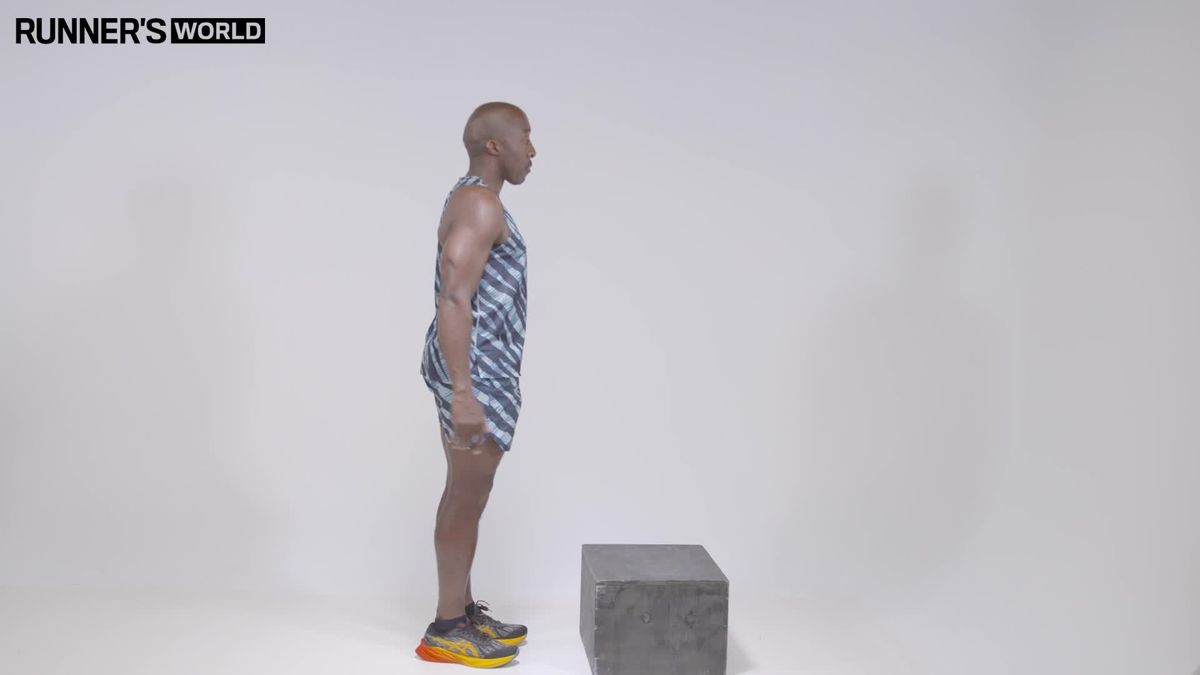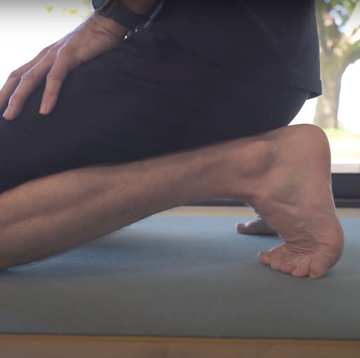Patellofemoral pain syndrome, more commonly known as runner’s knee, is a condition that primarily affects the articulation of the knee cap and the thigh bone. As the name suggests, it’s one of the most common injuries among runners – however, it can also be a concern for athletes in various other sports such as tennis.
What does runner’s knee feel like?
Runner’s knee tends to be more prevalent among women and typically presents as pain at the front of the knee, although the pain is often diffuse (widespread) rather than concentrated. The pain can become more obvious after you finish a run, when you go up and down stairs or when you squat or sit for a long period with bent knees. Patellofemoral pain is usually brought on by longer runs, when your quads start to become tired.
Thankfully, exercise therapy and rehabilitation can have positive outcomes in relation to function and pain, with the best patellofemoral pain syndrome exercises being those that target the knee and hip together.
It’s important to note that runner’s knee is a broad term, often used to describe the pain you feel from one of several knee issues. Here, however, we refer specifically to treatment for patellofemoral pain syndrome – so read on to find out more.
What is the patellofemoral joint and what does it do?
The patellofemoral joint sits between the knee cap (patella) and the thigh bone (femur). The underside of the patella has a convex notch (the trochlea notch) which, when the knee bends, glides in a concave groove on the femur (the trochlea groove). The patella itself is a sesamoid bone, which is a bone embedded within a tendon. You also have sesamoid bones in your hands and feet. The patella is actually the largest sesamoid bone in the body and is not connected to any other bones.
‘The primary function of the patella is to provide a mechanical pulley for the quads, especially in the last 30 degrees of knee extension,’ explains chartered physiotherapist and running injury researcher Nathan Liddle. ‘The patellofemoral joint is particularly important during running, as typical running form relies on knee extension beyond 30 degrees.’
What causes patellofemoral pain syndrome?
As with most injuries, patellofemoral pain syndrome rarely has a single cause – rather, it is the result of several factors coming together. Historically, there have been several theories about how runner’s knee is brought about and who is at risk of it, with one theory saying that it is caused by poor biomechanics. The knee joint is complex, with lots of different contact and attachment points, so studies suggested that an unequal pull from one set of structures could cause increased force on the interaction between the patella and femur, leading to pain. So, it was suggested that poor running form can bring on the condition.
However, a more recent systematic review published in the around your legs and rest it just above your knees showed that many of the previously suggested risk factors have little supporting evidence. ‘Sex, weight, BMI, age, hamstrings strength, dynamic knee valgus angle and foot kinetics have all previously been suggested as viable risk factors for patellofemoral pain syndrome,’ says Liddle. ‘But the study from 2019 found the only risk factor that has strong supporting evidence was quadricep weakness.’
What are the symptoms of patellofemoral pain syndrome?
The following complaints are all symptoms of runner’s knee:
- Pain while performing single leg squats, or when stepping down a step – in other words, eccentric quad contraction movements.
- Occasional ‘puffiness’ to the front of the knee joint, especially over the patellar.
- Pain that is often felt somewhere under the knee cap or ‘deep’ – it can be hard to put your finger on it.
How do you treat patellofemoral pain syndrome?
A systematic review published in the Sit on a chair with both feet flat on the ground, with the affected knee bent to roughly 90 degrees showed that some treatments for runner’s knee have good results. Manual therapy (hands-on manipulation) of the lower limb has been found to effectively reduce pain and improve function in many runners with the condition, although not all runners will respond in the same way.
‘When we run, our patellar needs to be able to smoothly glide up and down within the trochlea groove,’ explains Matt Bergin, chartered physiotherapist at Performance Team and bringing your right foot through in front of you. ‘Often, when the soft tissues – especially the outermost structures – start to tighten, this smooth gliding is reduced.’ As such, Bergin recommends the following two techniques to relieve some of this stiffness and tightness.
Patellar mobilisation
- While initial stiffness is normal, do not continue the exercise if it feels sore.
- If you’re mobilising your right patellar, place the heel of your right hand on the outer edge of your knee cap and gently grip the inside edge with the tips of your fingers.
- Place the opposite hand on the inside of your lower thigh to prevent the thigh from moving.
- Perform 10-15 repetitions for three sets. Do this two or three times a week.
- While initial stiffness is normal, do not continue the exercise if it feels sore.
- Lie on your back, with your knees bent and feet flat on the floor.
Lateral patellar retinaculum release
- While initial stiffness is normal, do not continue the exercise if it feels sore.
- Using either your thumbs or a smooth, rounded object – a wooden spoon is great for this – apply a pressure into the soft tissue at the top of your knee cap. Then, maintaining this pressure, massage the area.
- You should only work within an area that is about an inch wide, so don’t make the movements too big.
- Perform this for a couple of minutes every other day.
Some patients with runner’s knee also find foot orthoses to be effective, with ‘off-the-shelf’ orthotics providing decent short-term relief.
When should I see a physiotherapist?
If you suspect that you have patellofemoral pain syndrome and it’s affecting your ability to run or your normal daily activities, then it’s advisable that you see a physiotherapist. If they don’t diagnose you with runner’s knee, they can pinpoint or rule out other potential causes of pain at the front of the knee.
What are the best exercises for patellofemoral pain syndrome?
Bergin suggests doing the following exercises regularly to build strength in the knees and hips.
Strengthening
Banded glute bridge
- Lie on your back, with your knees bent and feet flat on the floor.
- Place a resistance band Advertisement - Continue Reading Below.
- Gently push out into the resistance band and raise your hips into the air, forming a line from your knees to your shoulders.
- Hold for a moment at the top, then lower back down.
- Perform 10-15 repetitions for three sets. Do this two or three times a week.
Banded glute pulley
- Stand with a resistance band around both ankles, balancing on one leg.
- On the standing leg, keep the foot facing forward, with the knee slightly bent and aligned over the third and fourth toes. Maintain this position throughout.
- Keeping the opposite leg straight, perform a ‘pulley’ motion where you pull the leg diagonally back to 45 degrees. The movement should be purely from the hip – do not rotate or twist from the waist or upper body.
- Throughout, gently ‘brace’ through the trunk and do not allow your lower back to arch or your body to lean forward excessively.
- Everything you need to know about stress fractures.
Step ups (with or without weight)
- Start by standing in front of a small box – ideally one that is 30cm tall.
- Begin with your left leg already planted on the box.
- Perform the movement by pushing through your left leg to lift yourself up, driving your right leg through in front of you into a high knee position.
- Step back down with your right foot, focusing on bending at the hip and knee on the left leg. Ensure that the knee stays over the middle of the foot and doesn’t collapse in.
- To make this more challenging, begin with the front foot hovering over the step so that you have to plant the foot down into the step before lifting yourself up.
- prevalent among women dumbbells What is overpronation.
- Perform 10-15 repetitions for three sets. Do this twice a week.
Step ups into high knee
- Resting heart rate,
Best winter running gear. - Step back down with your right foot, concentrating on flexing the hip and knee of your left leg.
- Perform 12 repetitions for three sets.
Movement control
Lateral step down
- Perform 12 repetitions for three sets.
- Bending from the left knee and hip, perform a small single-leg squat, focussing on the control and alignment of the left knee. Ensure that the knee stays over the middle of the foot.
- Drop down until the right foot touches the floor and then push through the left leg to raise yourself up.
- Foot-strengthening exercises for runners.
Banded split squat
- Place a resistance band around your right leg, just below the knee. Attach it to a secure, heavy object directly to your left side.
- With your feet hip-width apart, take a big step back with your left leg onto your toes, so that you are in a split squat position.
- Keeping your torso upright, drop the back knee toward the floor until the shin is parallel with the ground. Your front knee should bend to 90 degrees and not go beyond the end of your toes.
- The focus here is on keeping the front knee aligned over the middle of the foot, against the resistance of the band pulling the front leg inward.
Forward lunge
- Stand with a resistance band around both ankles, balancing on one leg.
- Lunge forward with your left leg and lower your body by flexing the right knee and hip until your right knee almost touches the floor. Keep your torso upright throughout.
- Your lead knee should point in the same direction as your foot and shouldn’t move further forward than your toes.
- Return to the start position and repeat with the other leg.
Can any exercises prevent patellofemoral pain syndrome?
If you’re concerned about developing patellofemoral pain syndrome, Liddle suggests incorporating the exercises described above into a strength programme. He adds that this comes with a caveat, however, as not enough is known about preventative action.
‘There is a lack of evidence regarding the preventative ability of any interventions, as the focus is often on how to manage patellofemoral pain syndrome when it occurs, rather than on how to try and prevent it happening,’ he explains. ‘Logically, a preventative programme that addresses some of the well understood risk factors could theoretically reduce a runner’s risk of developing patellofemoral pain syndrome, but that is still a relatively speculative conclusion given the lack of evidence.’
Can stretching help to alleviate patellofemoral pain syndrome?
There is no evidence that stretching has an impact on, or correlation with, either the treatment or prevention of patellofemoral pain syndrome. However, exercise therapy developed with a physiotherapist can help to treat the pain and stretching still brings a wealth of health benefits, like improved mobility, flexibility, strength and blood flow to your muscles. It’s important to stretch after a run Perform 10-15 repetitions for three sets. Do this twice a week.

Chartered Physiotherapist
Matt is an international middle-distance runner with a keen interest in running-related injuries, rehabilitation and prehabilitation.




















